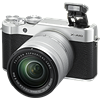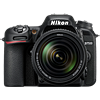Main
Model
Price
Advantages
launch
Announced
Body type
Camera subcategory
Sensor
Effective pixels
Max resolution
Sensor size
Sensor type
Processor
Image ratio w:h
Other resolutions
Sensor photo detectors
Image
ISO
Boosted ISO (minimum)
Boosted ISO (maximum)
White balance presets
Custom white balance
Image stabilization
Uncompressed format
JPEG quality levels
Image stabilization notes
Photography features
Minimum shutter speed
Maximum shutter speed
Maximum shutter speed (electronic)
Aperture priority
Shutter priority
Manual exposure mode
Subject / scene modes
Built-in flash
Flash range
External flash
Flash modes
Continuous drive
Self-timer
Metering modes
Exposure compensation
AE Bracketing
WB Bracketing
Screen / viewfinder
Articulated LCD
Screen size
Screen dots
Touch screen
Screen type
Live view
Viewfinder type
Viewfinder coverage
Viewfinder magnification
Videography features
File Format
Microphone
Speaker
Videography notes
Optics & Focus
Autofocus
Manual focus
Number of focus points
Lens mount
Focal length multiplier
Physical
Weight (inc. batteries)
Dimensions
Environmentally sealed
Battery
Battery details
Battery Life (CIPA)
Storage
Storage types
Connectivity
USB
HDMI
Microphone port
Headphone port
Wireless
Wireless notes
Remote control
Other features
Orientation sensor
Timelapse recording
GPS
GPS notes
Samples
Videos
Summary
The Nikon D7500 highest resolution of 5568 x 3712 pixels (21 megapixels) is better in comparison with the Fujifilm X-A10 maximum resolution of 4896 x 3264 pixels (16 megapixels). The Nikon D7500 offers a wider ISO range of 100-51200 than 200-6400 ISO range of the Fujifilm X-A10. This ISO numbers let the camera owner to make better photos in low light conditions. The Nikon D7500 has more number of white balance presets - 12. It gives the camera owner more control over colour. The Nikon D7500 has image stabilization that will allow the camera owner to make blur-free photos indoors without using a tripod. The Nikon D7500 provides more number of focus points than the Fujifilm X-A10: 51 vs 49. More number of focus points means less risk of losing focus lock while following a moving object.
The Fujifilm X-A10 display is better as it has more number of screen dots 1,040,000 in comparison to 922,000 dots of the Nikon D7500 display. The higher dot count display is better for reviewing images on your camera. The Nikon D7500 has Yes inch touch screen which is larger in comparison to No inch display of the Fujifilm X-A10
The D7500 supports external flash. It provides superior control over the exposure and lighting of the object in low light and in bright light conditions when the camera owner needs to fill-flash. The Nikon D7500 battery life is better than the Fujifilm X-A10 battery life. According to CIPA standards the camera owner will be able to take 950 shots with the D7500 and only 410 with the X-A10. The X-A10 weighs 331g that is 309g lighter in comparison with the weight of the D7500. The D7500 can utilize optional accessory GPS devices. This feature can be useful if the camera owner is a traveller, to be able to go into the image metadata and see exactly where a photo was produced.
The Nikon D7500 has 17 advantages and the Fujifilm X-A10 only 2 so the D7500 will be the best buy. Get the list of the best offers on Amazon.


